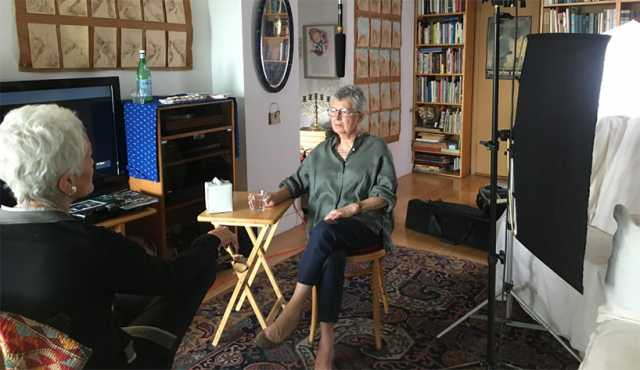USC Shoah Foundation redoubles efforts to collect testimonies of Holocaust survivors before it is too late

Miriam Katin survived the Holocaust as a toddler because her quick-thinking mother faked their deaths in Budapest at a historically perilous time for Jews in Hungary. Now 77, Katin has a thriving career as a graphic artist whose humor cartoons have appeared in The New Yorker.
Her remarkable oral history would have been lost to time without the initiative by USC Shoah Foundation to document the stories of Holocaust survivors before it is too late.
Formally announced today, the Last Chance Testimony Collection is enabling Holocaust survivors to share their stories for USC Shoah Foundation’s Visual History Archive, where they will exist in perpetuity.
Since its founding by Steven Spielberg in 1994, the Institute has compiled over 54,000 Holocaust testimonies, most of which were conducted before the year 2000. At that point, having surpassed the goal of recording over 50,000 interviews, the Institute shifted gears to focus on recording testimonies of other genocidal events, as well as finding ways to use its testimonies for research and education.
Now, the very youngest Holocaust survivors are 75 years old. Their numbers are rapidly diminishing, even as antisemitic incidents in the United States and Europe are steadily climbing.
According to the Conference on Jewish Material Claims Against Germany, only about 100,000 survivors of the concentration camps and ghettos remain worldwide.
“Now is the time,” said USC Shoah Foundation Finci-Viterbi Executive Director Stephen Smith. “We anticipate that within just a few years, it will no longer be possible to record the life stories of the people who survived this dark chapter of world history.”
During the years in which USC Shoah Foundation’s effort to collect large numbers of Holocaust testimonies was on hold, hundreds of Holocaust survivors reached out to request that their interview be recorded. Many expressed the hope that their stories will be used to educate future generations.
The Institute late last year initiated a soft launch of the Last Chance program, and began recording the testimonies -- generally in the order in which the requests were made.
So far, about 40 interviews have been conducted or are in the works under the Last Chance banner.
Katin gave her testimony to USC Shoah Foundation in October.
Born Maria Tobias in Budapest in 1942 – during the throes of World War II – Katin was 2 when the Nazi invasion of Hungary precipitated a historic push to exterminate all Hungarian Jews.
In just two months, some 430,000 Jews from the country were deported to Auschwitz-Birkenau; the majority were gassed on arrival.
In the chaos of the war, Katin’s parents became temporarily separated, and she was in the care of her mother, Esther Levy. In a frantic attempt to avoid detection, Levy faked the deaths of herself and Katin, and obtained false identification documents as a peasant woman and her illegitimate child.
The duo went door-to-door in the Hungarian countryside, begging anyone they could find to offer them refuge. In exchange, Levy offered her sewing skills.
Their plight didn’t end with the Germans. Russian soldiers, who seized Budapest in a horrific battle in late 1944, presented further problems.
One night, Katin and her mother were hiding in a cottage with other women and children when Russian soldiers barged in. The soldiers got drunk and began demanding that the women sleep with them. Some were raped. A soldier crawled into bed with Katin and her mother. Late in the night, the mother and daughter discovered he was dead – Katin says her mother had no idea what happened. Fearing for their lives, they stole off in the middle of the night as the other soldiers slept – escaping into the brutal January winter.
“My mother said they were shooting after us,” she said in her testimony.
In the next village, they came across a man who allowed them to stay with his family for a few weeks.
After the war, Katin’s parents reunited. In 1956, the family immigrated to Israel. The 16-year-old Katin, who’d always loved to draw, was done with school; she wanted a job. One day, while reading a newspaper, she saw an ad she liked. She grabbed the phone book, looked up the ad agency, found their address and knocked on the door. The company took her on as an apprentice. She soon served in the Israel Defense Forces as a graphic artist. Seven years later, Katin moved to New York City and plied her trade.
She married music educator Geoffrey Katin; they had two sons.
Today, her career is thriving. An award-winning comics and graphic artist, Katin’s humor cartoons have been published in The New Yorker and she has authored two autobiographical graphic novels. She wrote one of them after learning that her son – also a graphic artist -- wanted to move to Berlin.
“I was very, very upset about it,” she said in her testimony. “I didn’t know how to deal with the whole thing. I decided the only way I can deal with it is if I do a book about it.”
She titled the book Letting It Go.
“And when people ask me, ‘OK, did you?’ I say, ‘no,’” she said. “I didn’t let it go. But it’s a good title, and I had good intentions.”
To learn more and support the project, click here.